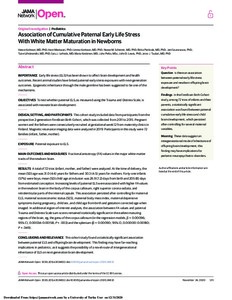Association of Cumulative Paternal Early Life Stress With White Matter Maturation in Newborns
Hasse Karlsson; Harri Merisaari; Linnea Karlsson; Noora M. Scheinin; Riitta Parkkola; Jani Saunavaara; Tuire Lähdesmäki; Satu J. Lehtola; Maria Keskinen; Juho Pelto; John D. Lewis; Jetro J. Tuulari
Association of Cumulative Paternal Early Life Stress With White Matter Maturation in Newborns
Hasse Karlsson
Harri Merisaari
Linnea Karlsson
Noora M. Scheinin
Riitta Parkkola
Jani Saunavaara
Tuire Lähdesmäki
Satu J. Lehtola
Maria Keskinen
Juho Pelto
John D. Lewis
Jetro J. Tuulari
AMER MEDICAL ASSOC
Julkaisun pysyvä osoite on:
https://urn.fi/URN:NBN:fi-fe2021042827504
https://urn.fi/URN:NBN:fi-fe2021042827504
Tiivistelmä
This cohort study examines infants and parents in the FinnBrain Birth Cohort to assess the association between paternal cumulative early life stress and offspring brain development.Question Is there an association between paternal early life stress exposure and newborn offspring brain development? Findings In the FinnBrain Birth Cohort study, among 72 trios of infants and their parents, a statistically significant association was found between paternal cumulative early life stress and child brain development, which persisted after controlling for several maternal variables. Meaning These data suggest an intergenerational mode of inheritance of offspring brain development; this finding may have implications for pediatric neuropsychiatric disorders.Importance Early life stress (ELS) has been shown to affect brain development and health outcomes. Recent animal studies have linked paternal early stress exposures with next-generation outcomes. Epigenetic inheritance through the male germline has been suggested to be one of the mechanisms. Objectives To test whether paternal ELS, as measured using the Trauma and Distress Scale, is associated with neonate brain development. Design, Setting, and Participants This cohort study included data from participants from the prospective 2-generation FinnBrain Birth Cohort, which was collected from 2011 to 2015. Pregnant women and the fathers were consecutively recruited at gestational week 12 from maternity clinics in Finland. Magnetic resonance imaging data were analyzed in 2019. Participants in this study were 72 families (infant, father, mother). Exposure Paternal exposure to ELS. Main Outcomes and Measures Fractional anisotropy (FA) values in the major white-matter tracts of the newborn brain. Results A total of 72 trios (infant, mother, and father) were analyzed. At the time of delivery, the mean (SD) age was 31.0 (4.4) years for fathers and 30.3 (4.5) years for mothers. Forty-one infants (57%) were boys; mean (SD) child age at inclusion was 26.9 (7.2) days from birth and 205 (8) days from estimated conception. Increasing levels of paternal ELS were associated with higher FA values in the newborn brain in the body of the corpus callosum, right superior corona radiata, and retrolenticular parts of the internal capsule. This association persisted after controlling for maternal ELS, maternal socioeconomic status (SES), maternal body mass index, maternal depressive symptoms during pregnancy, child sex, and child age from birth and gestation corrected age when imaged. In additional region-of-interest analyses, the association between FA values and paternal Trauma and Distress Scale sum scores remained statistically significant in the earliest maturing regions of the brain, eg, the genu of the corpus callosum (in the regression models, beta = 0.00096; 95% CI, 0.00034-0.00158; P = .003) and the splenium (beta = 0.00090; 95% CI, 0.00000-0.00180; P = .049). Conclusions and Relevance This cohort study found a statistically significant association between paternal ELS and offspring brain development. This finding may have far-reaching implications in pediatrics, as it suggests the possibility of a novel route of intergenerational inheritance of ELS on next-generation brain development.
Kokoelmat
- Rinnakkaistallenteet [27094]
